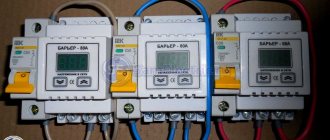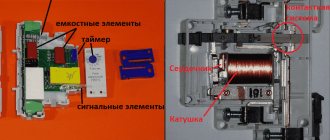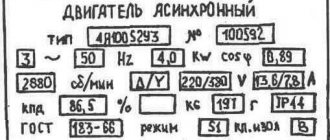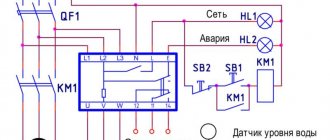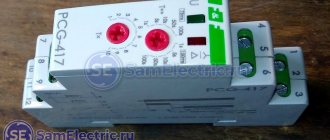Voltage drops are far from uncommon in domestic homes. They occur due to wear and tear of electrical networks, short circuits and uneven load distribution across individual phases.
As a result, household appliances either do not receive enough electricity or burn out from its excess. To avoid these problems, it is recommended to install a voltage control relay (VCR).
We propose to understand what advantages the use of such a device provides, what are the differences between an RLV and a stabilizer, how to choose a suitable relay and connect it.
Why do you need a voltage control relay?
Household electrical appliances are designed for a voltage of 220-240 V. From time to time, emergency situations arise in the electrical network. The voltage in the outlet jumps up or down. Jumps can disrupt the operation of household appliances or completely destroy them.
Voltage drops in the network
A common case of voltage drops is a zero break. In this case, in one phase the voltage drops below the permissible level. On the other, on the contrary, there is a significant increase in voltage up to 380V.
Another situation is typical for old houses with poor electrical wiring and loose contacts. Due to the poor condition of the cables and their overload, the voltage in the sockets can drop to 170 V or lower. This is dangerous for electric motors of washing machines and refrigerators.
A voltage control relay protects electrical appliances. This small device is located in the distribution panel of the apartment. It has a compact design, is conveniently mounted on a DIN rail and performs its task completely autonomously.
Additional Information. It is necessary to distinguish voltage control relays from all kinds of stabilizers and UZMs. All of the listed devices are used to protect household appliances. The stabilizer is an active device. He is able to independently adjust the voltage in the apartment. The RN performs a simpler and more passive function. It simply turns off the consumer when the permissible threshold is exceeded and, in itself, does not affect the voltage in any way.
Types
The most popular types of relays designed for phase control include EL models of the following series - 11, 12, 13, 11MT and 12MT.
It is important to take into account that the scope of application of the product depends on their types of voltage phase control relays (EL):
- 11 and 11 MT - protection of power supplies, participation in the automatic transfer system, power supply of converters and generator sets.
- 12 and 12MT - to protect cranes with a power not exceeding 100 kW.
- 13 - used when connecting electric motors of a reversible type with a power of up to 75 kW.
The devices are fixed on a special DIN rail or only with screws (depending on the situation).
Design and principle of operation of a voltage relay
As can be seen in the figure above, the voltage relay consists of two main blocks: a measuring and an actuating block (relay).
When voltage is applied to the relay, the measuring unit determines its value and if the measured value of the mains voltage is within the range of values set in the relay settings, the measuring unit sends a signal to the executive unit (relay) which, in turn, closes the power contact, thereby including the load.
The measuring unit continuously monitors the mains voltage; if the voltage drops or increases above the value set in the settings, the measuring unit immediately sends a signal to the actuator (relay), which, in turn, turns off the load. After the voltage value is restored, the measuring unit, after a time delay set in the settings (usually can be set in the range from 5 seconds to 15 minutes), sends a signal to the actuator, which turns on the load again.
Types of launch vehicles
Various types of devices need protection from voltage surges. Some of them operate on household voltage 220 V and consume minimal power. Examples of such devices include smartphone chargers or LED light bulbs. Others also operate on 220 V, but already consume thousands of watts of power, for example, electric kettles and irons. Still other devices require three-phase power supply of 380 V. A conventional single-pole LV is not suitable for them. Among such consumers are industrial machines and powerful asynchronous motors. Therefore, all relays for voltage control are usually divided by type of housing and type of load.
By case type
This classification indicates which devices and in what quantities can be connected to the relay. According to the type of execution, the launch vehicle is divided into 3 types:
- rosette;
- in the form of an extension;
- with installation on DIN rail.
The first type is the easiest to use. This surge protection relay plugs directly into an outlet. On one side of the case there is a corresponding connector in the form of a plug. On the other part of the device there is a standard socket for connecting the load. This type of LV can be quickly removed and connected to another location.
It will be interesting➡ Connection diagram for a single-phase and three-phase electric meter: step-by-step instructions
The second type is made in the form of an extension cord. On its surface there are several sockets for loading. Unlike type 1, this relay is equipped with a cable and plug. The device is convenient for stationary connection of office equipment.
The third type is the most professional. The pH is installed in the shield. It has an extended list of functions, high throughput, and at the same time protects all electrical appliances in the apartment.
By number of phases
Electrical consumers operating on alternating current are divided into 2 groups. The voltage control relay has a similar division. Namely:
- single-phase LV;
- three-phase.
Single-phase modification is suitable for home use. These relays are installed in apartments, garages and cottages. They pass through one phase and zero. That's why they are called single-phase.
The operating voltage for such LVs is 220V. Their contacts are designed for a current of 30-40 A, which corresponds to the maximum values for residential wiring. The device has a minimal list of settings and, if you read the instructions, is suitable for use by an ordinary person without specialized education.
Three-phase voltage monitoring relay ZUBR 3F
The second type of relay is more complicated. It controls voltage on 3 phases simultaneously. This modification is suitable for units consuming 380 V from a network. The relay has an expanded list of adjustments and requires minimal experience in setting up automation systems.
Technical specifications
The main characteristics of the LV include operating voltage, number of connected phases and maximum throughput power. Below are the parameters of one of the popular relays - RV-32.
| Characteristic | Meaning |
| Supply voltage | 220 V |
| Maximum active power of the consumer | 7 kW |
| Load current limit | 32 A |
| Measurement error | +/-1 % |
| Degree of protection against dust and moisture | IP20 |
| Number of relay operating cycles | 100 thousand |
| Working temperature | from -5 to +40°C |
| Limit cross-section of connected wires | 6 sq. mm |
From the characteristics it follows that the relay is powered by a mains voltage of 220 V. The internal contacts are capable of continuously passing a current of 32 A, which corresponds to a consumer with a power of 7 kW. IP class 20 says the device is not suitable for use in wet areas or outdoors. It can be installed in a special electrical panel. 100 thousand operating cycles is the number of switching on and off of the relay that it can withstand without destruction.
Voltage relay DigiTOP Vp-50A IP20
Voltage relay selection
The choice of a voltage relay begins with the choice of its design (type).
The following types of voltage relays exist:
— By type of electrical network: single-phase and three-phase
— By installation method: stationary and portable.
As shown in the picture above, permanent installation voltage relays are divided into two subgroups:
— voltage relays intended for installation in electrical panels are, as a rule, used to protect all electrical appliances connected to the network; this is also their main advantage; when installing a general voltage relay in the input electrical panel, the entire electrical network is protected, accordingly, the need to install several voltage relays disappears, thereby significantly reducing the cost of organizing the protection of the electrical network from voltage surges.
- socket relays - voltage relays built into the socket, used if for some reason it is not possible to install a voltage relay in the electrical panel, and can also be used in conjunction with the above relays, if there is a need to set individual settings for specific equipment. For example, because It is recommended to turn on refrigerators after a power outage no earlier than 5 minutes; to protect them, an additional voltage relay is often installed, so after a drop and restoration of the normal voltage value, the general relay turns on the load, for example, after 1 minute, and the socket relay installed for connection The refrigerator will turn it on only after 5.
Finally, portable voltage relays can be of two types: plug-socket and extension cord. The design of these relays is similar to stationary socket outlets, and although they are more bulky, these types of relays have become quite widespread due to three important advantages: no need for their installation; portability, i.e. the ability to take them with you on the road to protect against surges in any place, for example in the country; and, as in the case of stationary socket relays, the ability to set individual settings for specific equipment.
— By type of protection: simple, with protection only against voltage surges and with combined protection.
An example of a relay with combined protection is a current-voltage relay, which controls not only the voltage, but also the current of the electrical network, thereby protecting it from both voltage surges and overloads, i.e. additionally performs the function of a power limiter.
IMPORTANT! A voltage-ampere relay does not provide network protection against short-circuit currents and therefore cannot replace a circuit breaker!
Example of a current-voltage relay:
Having selected the desired type of relay from those listed above, you can begin to determine its required characteristics.
The main characteristic of a voltage relay is its rated current; the value of the rated current is indicated on the relay body and in its passport.
Rated current is the current that the relay is capable of passing through itself for a long time while maintaining its functionality. This implies the main condition for choosing a voltage relay: the rated current of the voltage relay must be greater than or equal to the current of the protected electrical network.
Inom. RN⩾I network
Standard relay rated current values are: 10; 16; 25; 32; 40; 50; 63 and 75 Amps (the values shown are the most common)
The calculation of the power supply current can be determined using our online calculator, or you can calculate it yourself as follows:
1) We determine the power of the network by summing the powers of all electrical appliances connected to the network protected by the calculated voltage relay:
Pnetwork=(P1+ P2…+ Pn)*Ks, kW
where: P1, P2, Pn are the powers of individual electrical receivers; Ks - demand coefficient (takes into account the non-simultaneous connection of electrical appliances to the network) Ks is taken from 0.65 to 0.8, if only 1 electrical receiver is connected to the network or a group of electrical receivers that are connected to the network at the same time Kc = 1.
Note: Network power is determined in kilowatts (1 kiloWatt=1000Watt)
It will be interesting➡ Description of the electrical circuit diagram with an example
2) We determine the network current by multiplying the calculated network power by a conversion factor (Kp) equal to: 1.52 for a 380 Volt network or 4.55 for a 220 Volt network:
Ineti=Pneti*Kp, Ampere
Based on the calculated value of the mains current, we select the nearest higher standard value of the rated current of the voltage relay.
Note: It should be remembered that the voltage relay does not protect the electrical network from overcurrents (overload and short circuit currents), therefore the voltage relay itself must be protected from them by a circuit breaker installed in series with it, therefore the rated current of the voltage relay can be taken based on the rated current of the machine based on the condition that the rated current of the relay must be greater than or equal to the rated current of the machine installed before it:
Inom. RN⩾ I nom. AB
Briefly about the main thing
To protect home equipment from network overloads, it is necessary to install protective automatic equipment in it. You can use a regular relay that will control the voltage. The device will constantly measure the readings of the latter. And if you deviate from the set norm, independently disconnect from the power source.
You can provide protection to each individually connected household device. For this, special adapters and extensions are produced. But it is more reasonable to protect the entire home electrical network from overvoltage by installing one relay directly in the apartment’s electrical panel.
Connecting the automation is simple. The relay is installed immediately after the meter, breaking the phase wire. The main attention is paid to setting up the device. Reliable protection will be provided by setting upper and lower response thresholds. As well as the delay time before turning on again.
Voltage relay connection diagram
Let me show you once again what the connection of a voltage relay in an electrical panel looks like:
Voltage relay installed in the electrical panel. Voltage 220V.
The photo shows a Digitop voltage relay, as a review I can say that I connected these several times, there were no problems.
The voltage relay must be protected by an input circuit breaker. The machine can be placed before or after the counter, but it must be there in any case. The rating of the machine is one step less than the rated current of the voltage relay. In the above case, this rule does not apply:
Automatic machines, counter, voltage relay
In justification, I can say that in voltage relays they usually put a relay one step larger. I discovered the Ukrainian Barrier and Digitop, for example, with a nominal value of 32 A, the voltage relay circuit contains a 40 A relay, which is very commendable.
One phase or three?
The next point you should pay attention to is what current the device is designed for:
- Single phase. The most commonly used type of connection in residential premises (apartments, houses, cottages). If your wiring is designed for 220 V, then you should install a single-phase voltage relay.
- Three-phase. Such relays are used to protect powerful consumers (machines, refrigeration equipment, welding machines, etc.) that require 380 V for their power supply. They control voltage in three phases. If one of them is de-energized, all three are switched off.
If you do not have high-power consumers that require a three-phase connection, it would be better to install a single-phase relay. And if there is, then it will be more reliable to make the connection using a contactor.
A contactor (starter) is a device used for frequent remote switching on/off of electrical circuits. Its use is required for heavy loads (more than 7–8 kW). To choose the right contactor, you need to calculate the load under which it will be operated.
pros
- In the private sector with overhead power lines and a weak transformer (where the average is 160-180 V), this is simply an irreplaceable thing, especially in my case. Frequent jumps due to wind, welding, etc. A conventional relay is constantly turned off because there is no delay. When TOMZN TOVPD1-63 was installed, I had to set the lower limit to a minimum of 145 V and dream of such functionality as a shutdown delay. TOMZN DDS238-VAP 80A has it all. I installed it on 09.09.19, while there was no wind - I’ll see how the new one copes! Three months - everything is OK. There was also a squally wind, until there was an accident on the main line.
- The price is even cheaper than the first one (possibly due to the $ exchange rate). TOMZN TOVPD1 — 631.38 rubles or $14.85. TOMZN DDS238-VAP 80A - 967.13 rubles or $14.35. Domestic analogues are 2.5–3.5 times more expensive!
Connecting multiple voltage monitoring relays
Technical conditions allow connection to a private house or apartment of three phases. If three-phase units are used to protect electrical equipment, then in the event of an emergency, all equipment on one branch will be de-energized, which is not very convenient. This problem is solved by three relays connected separately to each phase.
From the bottom terminal of the machine we make a connection to the input of the first block. From the other terminal - to the input of the next block. For ease of maintenance and repair, this should be done with multi-colored wires, while remembering that blue is always “zero”. We connect the neutral wire to the neutral bus.
You can install separate input circuit breakers so that, if necessary, de-energize the desired relay if you suddenly have to turn it off. As you can see, the installation is no different from the examples discussed above, only instead of one block there are three at once, each for its own phase.
We connect the relay outputs to automatic machines, which each go directly to their own load: lighting, sockets, boiler. Accordingly, each relay can be set to a different delay time.
Nuances of choosing a device
When choosing a voltage relay, you need to pay attention to the following parameters:
- Element performance.
- Possibility of regulation (setting the required delay time, as well as response limits).
- Rated current value.
If the device has a digital indicator, it will be easier to configure, but in general the presence of such a component does not play a significant role. Before you go shopping or order a device online, it would be a good idea to visit specialized forums and read reviews.
Pay attention to whether manufacturing company employees communicate with users. Openness indicates that the company is confident in its products.
How do they work?
When the voltage values fall outside the specified range (190–250 V), the RKN microprocessor de-energizes the network. The relay continues to monitor the input voltage and, when it reaches normal values, resumes power supply. The device’s response to shutdown is instantaneous - 0.02–0.10 seconds. Turning on the network is delayed by 5–6 minutes. The reason is that sudden starting and stopping of the engine is undesirable for most electrical appliances and can lead to their breakdown. It is not for nothing that in many operating instructions for household appliances the restart time is specifically specified (usually 5–10 minutes).
Advantages of relays compared to stabilizers
Using a voltage relay for an apartment or for a house, if the stability of the line allows it, is in many ways preferable to installing stabilizers. Let us list the main advantages of the RKN:
- Compactness. This device takes up much less space than any stabilizer.
- Easy to install. The network voltage control element can be installed inside the electrical panel on a DIN rail, and you don’t even have to bother with connecting cables for a long time. And to install the stabilizer, you will have to cut into the line (when installing the device indoors) or place the device inside a specially made protective box, next to the shield.
- Fast response. This is the main advantage of the voltage control relay. With a sudden jump in the potential difference, the element is triggered in just a few milliseconds. In this matter, only triac stabilizers, the price of which is an order of magnitude higher, can compete with RKN.
- Silence. The relays operate quietly, while the operating stabilizer can be heard even at a fairly long distance.
- Economical. In comparison with stabilizing devices, potential difference control elements consume a negligible amount of electricity.
- Low price. As already mentioned, voltage control relays are many times cheaper than stabilizers.
It will be interesting➡ What is a phase, how to determine phase and zero in electricity
Considering the above advantages of RKN, it becomes clear why, if possible, you should choose them. And yet, having become familiar with the advantages of these elements, there is no need to get carried away and install them everywhere instead of stabilizers.
If you use a relay as a voltage cut-off for a refrigerator, and the potential difference in the network regularly jumps, then constant switching on and off of the power will result in the expensive unit breaking down in a few months.
Purpose of the voltage control relay (VCR)
All consumer equipment operates from the rated voltage inherent in the networks, equal to 220 V. In fact, voltage fluctuations are constantly present and the client receives constant surges at the output of the electrical networks. Deviations of 10% are considered normal. But it is not uncommon for measuring instruments to record drops in readings of up to 70 V, surges of up to 370 V. Equally low and high voltages are dangerous for electrical consumers. Operating such a system without protective devices is extremely undesirable. General view of the voltage control relay
The protective shutdown assigned to the voltage relay will de-energize the electrical device during a voltage drop, and the automatic shutdown (turn on) function will save the life of the product or its individual electronic devices (fuse, motherboards, relays, etc.). Do not confuse RKN with devices for monitoring the break of zero, neutral, short circuit, etc.
The protective voltage relay is used:
- to protect single-phase and three-phase networks;
- for protection against sticking, breakage, phase imbalance, excessive load currents;
- to protect equipment from malfunctions;
- in devices using highly loaded motors;
- in public organizations with large sets of devices with high load current and load power of the electrical network.
Tips for choosing RKN
To correctly and rationally choose a device to protect devices and equipment, you must follow the following tips:
- It is advisable to purchase equipment at specialized retail outlets, where they will provide advice on the selection, installation, operation of the product and provide a guarantee for the goods sold;
- The more complex and functional the device, the higher its cost. The price of the RKN depends on the following factors:
- type of device - socket type will be the least expensive, rack type - the most expensive;
- manufacturer;
- design, material of relay parts;
- additional product functions;
- correct selection of the device according to the power of the protected household appliances. For normal operation of the system, it is advisable to use a relay with a power 25% higher than the rated one based on the sum of all consumers included in the electrical circuit. That is, with a rated power of the transformer used of 10 A, it is necessary to install a protective relay with a threshold of at least 13 A. It is worth noting that all three-phase devices are designed for 16 A;
- the presence of a digital indicator (display) for visual monitoring of network operating parameters;
- the body material should preferably be made of materials that do not support combustion;
- the presence of a function for adjusting the protective shutdown time to prevent frequent operation of the device;
- availability of a passport with the technical characteristics of the device, electrical diagram;
- the presence of a function to protect the device from overheating, measuring network power to disconnect the load.
Reasons for operation of the voltage relay
Installing this protection allows you to avoid failure of household and industrial equipment, as well as prevent possible fire of devices.
Electrical wiring fault
One of the cases when the protection is triggered is when the neutral wire burns out in the input panel to the building. Moreover, instead of 220V, the outlet can have any voltage - from a few volts, which leads to failure of electric motors of refrigerators and air conditioners, to 380V, at which any equipment burns out - from light bulbs and chargers for mobile phones to TVs and computers.
Danger of overvoltage
Since the wire insulation is designed for a voltage significantly higher than the nominal value, breakdown most often does not occur. If the electric pulse operates for a short time, then the voltage at the output of power supplies with a stabilizer does not have time to increase to a critical value. The same applies to ordinary light bulbs - if the sharply increased voltage quickly returns to normal, then the spiral does not have time not only to burn out, but even to overheat.
If the insulating layer cannot withstand the increased voltage and its breakdown occurs, then an electric arc appears. In this case, the flow of electrons penetrates through microcracks that have arisen in the insulation and goes through the gases that fill the resulting tiny voids. And the large amount of heat generated by the arc contributes to the expansion of the conductive channel. As a result, the current increases gradually, and the circuit breaker trips with some delay. And although it only takes a few moments, they are quite enough for the electrical wiring to fail.

